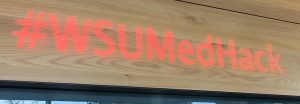May
07

Posted by Ann Madhavan on May 7th, 2018
Posted in: Data Science

Today’s blog is by Nancy Shin, Sewell Memorial Fund Librarian Fellow at Washington State University’s Elson S. Floyd College of Medicine. Welcome, Nancy!
The most extraordinary thing happened to Washington State University’s Elson S. Floyd College of Medicine (ESFCOM) the weekend of April 13 -15, 2018. ESFCOM hosted its inaugural Hackathon, which was organized by the College Technology Incubator Officer, Andrew Richards. It was well attended by people from all walks of life and subject expertise including students and healthcare providers. So, the big question is what exactly is a hackathon and why all the hype?
A hackathon is a social event that is focused on building small, innovative, and new technology projects. It brings together teams of people to work on a common project within an overarching theme; at the end of the event, teams formally present their projects for judging. The hackathon can last from 4 hours to 1 week (sleep is optional) and can involve large cash purses as prizes. Typically, projects are technological and can result in the development of a new app or feature on a website in response to a theme; in the case of ESFCOM’s Hackathon, the theme was “challenges in rural healthcare.” The common misconception about a hackathon is that it is an event that is strictly designed for computer programmers, engineers, and software developers – i.e. anyone who codes! However, other skills like research, design, project management, data management, and leadership are also important to the dynamic of an ideal hackathon team.
Arguably the first hackathon was hosted by OpenBSD in 1999, which is an operating system; ten developers came together to work on various software problems over the span of a week (Davis, 2016). Since then, hackathons have more famously been hosted by various companies like Facebook and Yahoo in 2005 and 2006, respectively, in order to catalyze new innovations in a relatively “risk-free” and “creative” environment (Davis, 2016). In general, hackathons are organized by one of the following communities: open source software companies, tech companies, sponsored competitions, and community institutions (Davis, 2016).

PTme, the winning team
In the health field, a big community hackathon organizer is the National Institutes of Health (NIH) which often hosts hackathons with a bioinformatics theme. Although the ESFCOM’s Hackathon was heavily inspired by MIT’s “Grand Hack & Hacking Medicine,” what makes the community hackathon at ESFCOM so different and unique from other health hackathons is that it encourages a diverse skillset to tackle healthcare problems. For example, the winning team PTme was made up of a diverse skillset that included developers, medical students, business leaders, and engineering students while my own hackathon team was made up of a mathematician, bioengineer, computer engineer, designer, and health/data librarian. Another unique feature of the ESFCOM’s Hackathon was the involvement of health librarians in the Spokane area in creating a “Research Station” that provided active research and data management for the participating teams. The volunteer librarians were able to provide direct research support to assist with each team’s research and data management needs. It is those two qualities, skill diversity and library support, which makes ESFCOM’s Hackathon one of a kind and a successful model for other health communities/organizations to follow for their future hackathons!
References:
Davis, R. C. (2016). Hackathons for libraries and librarians. Behavioral & Social Sciences Librarian, 35(2), 87-91. doi:10.1080/01639269.2016.1208561